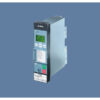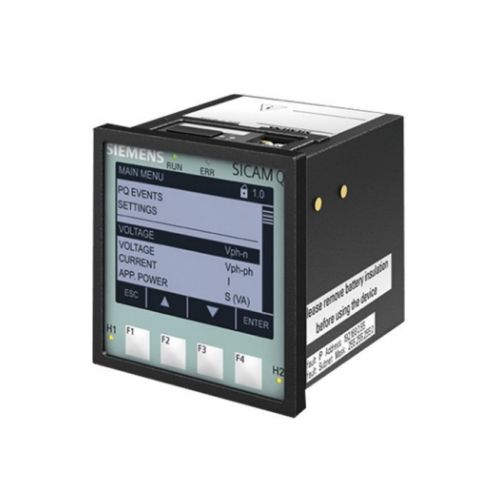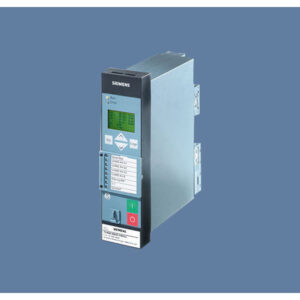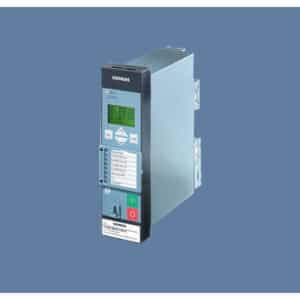Siemens SICAM Q100 Power Quality Instrument / Recorder
Description
Siemens SICAM Q100 Power Quality Instrument / Recorder
Siemens SICAM Q100 Power Quality Instrument also known as Q100 power quality recorder multifunctional measuring device is used for acquisition, visualization, evaluation and transmission of electrical measured variables such as alternating current, alternating voltage, frequency, power, harmonics etc. The acquisition, processing and accuracy of measured variables and events are performed according to the IEC 61000-4-30 Class A power quality measurement standard.
The measured variables can be output to a PC or system control via communication interfaces or shown on a display. In addition to the monitoring function, the SICAM Q100 all-in-one device provides a combined recording and evaluating function: measured values can be recorded in parameterizable time intervals with various recorders such as power quality and fault recorders. Longtime data and events are evaluated directly in the device and displayed as a report according to the power quality standards (e.g., EN 50160).
Siemens Q100 power meter Applications
Power quality – supply quality
Quality is generally regarded as an important aspect of any power supply. Insufficient power supply quality has a negative impact on operational processes and operational safety of consumers connected to the network and can entail serious consequences, ultimately resulting in increased costs for the user and supply utility.
The EN 50160 power quality standard describes the main voltage characteristics at customer’s supply terminals in public low, medium and high-voltage systems. Comprehensive acquisition and documentation of parameters relevant to the supply quality is a necessary step required to identify possible weak points and initiate appropriate measures to eliminate them.
Application
The SICAM Q100 device is used in single-phase as well as in three-wire and four-wire systems (with neutral conductor). The device is applied wherever comprehensive measurement of supply quality is necessary – at power utilities as well as in industry and trade sectors.
Technical specification
Input measuring circuits
- 4x alternating voltage, 4x alternating current
Binary input / outputs
- 2 individually programmable binary inputs / outputs
- Binary expansion (up to additional 12 inputs and 12 outputs) by using SICAM I/O Unit devices
Measured variables
- Measured value acquisition according to the IEC 61000-4-30 Class A power quality measurement standard
- Mean value, event and fault recorder functionality
- Load Profile and TOU (Time of use, 2 x Tariffs)
- Power frequency, active, reactive and apparent power, power factor and active power factor, phase angle
- Alternating voltage and alternating current harmonic up to the 63rd order
Communication interfaces and protocols
- Ethernet: MODBUS TCP, IEC 61850 Edition 2
- MODBUS Master and Gateway function for RS485 devices (as Switcher 3WL, PAC3x00, SICAM P50)
Operation and display
- Full graphic display, operation via 4 function keys
- Integrated web server to interact with PC via HTML pages
Time synchronization
- Via Ethernet: NTP client (Network Time Protocol)
Auxiliary voltage
- DC 24 – 250 V and
- AC 110 – 230 V, 50/60 Hz
Housing specification
- Compact dimensions: 96 x 96 x 100 mm (W / H / D)
Special features
- PQ reporting according to EN 50160 and CBEMA direct over HTML web server
- Evaluation of events directly in HTML via COMTRADE Viewer/SIGRA Plugin
- Flexible data export in the PQDIF, COMTRADE and CSV format
- Memory capacity of 2 GB for storage of the recorder data for years of power quality data
- MODBUS Master and Gateway function
Many electronic devices and automation systems in industrial production plants are sensitive to voltage variations and dips in the power supply that are often caused by the unexpected connection of energy sources, such as renewable energy and large energy consumers. The production systems themselves can also cause faults and feed them back into the distribution system. The risk? Plant shutdowns and production loss. The answer? Power quality. Power quality needs to be continuously measured and analyzed so that unexpected risks can be detected early on. Explore the power quality and measurement products with us. Click here!








Reviews
There are no reviews yet.